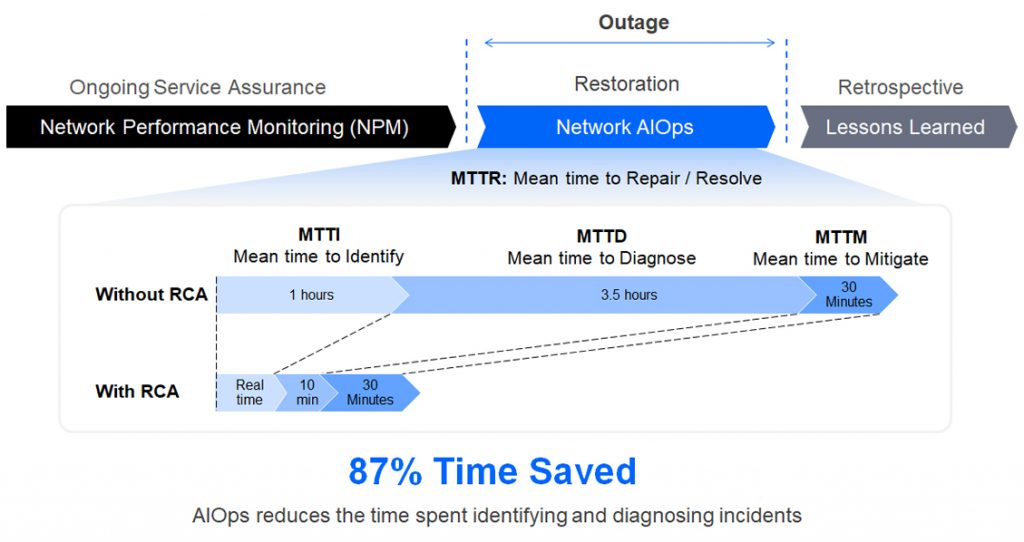|
Getting your Trinity Audio player ready...
|
AIOps systems can even pinpoint the root causes of issues. For example, AIOps platforms leverage ML algorithms to identify the root cause of incidents amid a flood of alerts. AIOps is like having a virtual engineer watching over your network – spotting problems early, helping remove duplicate alerts, identifying false positives, providing early anomaly detection, and even suggesting fixes – all at machine speed. This is a big deal for operations teams and business leaders, because it means less downtime, quicker repairs, and more efficient use of resources.

At MWC25, DriveNets showcased a powerful new AIOps feature – Root Cause Analysis (RCA), powered by AI. In a live demo, DriveNets’ AIOps RCA showed how it can transform the troubleshooting process for telecom networks.
Let’s imagine a typical scenario where a major enterprise customer reports that its branch offices are experiencing painfully slow network performance. Traditionally, the network operations center (NOC) would scramble to pull up dashboards, comb through device logs, and coordinate across teams. It might take hours to identify whether it is a device failure, a misconfiguration, or something else entirely.
In the DriveNets demo, the AIOps platform automatically detected an anomaly in the network’s traffic patterns. Instead of treating each alarm in isolation, the system correlated numerous events across the network into one incident. It flagged the affected region and immediately began analyzing possible causes. The AI quickly zeroed in on the real issue, connecting dots that might not be obviously related.
To make collaboration even easier, the platform included an AI-driven chat interface right in the incident console. The NOC team gets an intuitive chat interface to query incident details or receive actionable recommendations in multiple languages. DriveNets’ RCA tool integrates severity and weight metrics to reflect both immediate and broader network impact. This includes unconventional correlations, linking events across diverse and seemingly unrelated components.
The AIOps RCA tool improves network reliability (fewer and shorter outages) and speeds up incident resolution dramatically. As shown in the diagram below, the total time spent identifying, diagnosing and mitigating incidents was reduced by 87% in the DriveNets demo.
 Diagram 2: DriveNets AIOps RCA – reduced MTTR by 87%
Diagram 2: DriveNets AIOps RCA – reduced MTTR by 87%
In practice, that’s a huge boost to operational efficiency. When your ops team can address problems in minutes instead of hours, it can handle more issues in a day and spend more time on proactive network improvements rather than firefighting. This efficiency gain ultimately helps reduce operational expenses (OpEx) thanks to less overtime firefighting, fewer truck rolls, and more streamlined operations.
What are the Key Capabilities of DriveNets AIOps Root Cause Analysis?
So, what makes DriveNets’ approach to RCA so effective? It’s a combination of smart capabilities working together. Here are the key capabilities at a glance:
- Intelligent incident correlation: DriveNets AIOps doesn’t just collect alarms – it understands how they relate. It automatically correlates alarms, integrating severity and impact metrics, beyond simple parent-child relationships. For example, an interface error on one router and a QoS alert on another device might be treated as separate issues by legacy systems, but DriveNets AIOps can recognize if they are part of the same chain of events.
- AI-driven multilingual chat support: Engineers can ask questions like “Have we seen this issue before?” or “What’s the impact of this incident?” and get instant answers or recommendations from the AI. It’s an intuitive way to interact with the AIOps platform, especially during high-pressure incidents when quick information is key.
- Remediation suggestions: Once the root cause of an incident is identified, the system can suggest concrete remediation steps. Of course, the human experts remain in control to approve any action, but having AI-driven recommendations can save precious time and reduce the chance of errors.
Faster Resolutions, Fewer Outages, Lower OpEx
All these capabilities combine to make network operations more efficient and reliable. Both industry research and real-world deployments of AI in network operations show the following dramatic improvements:
- Improved speed and efficiency: According to Telia’s tmforum catalyst, automating incident correlation and root cause analysis can accelerate problem detection and diagnosis by up to 90%, and improve overall mean time to repair (MTTR) by 37% on average.
- Significant operational cost savings: A predictive maintenance automation project achieved roughly 30% OpEx savings through smarter, AI-driven service assurance. Those savings come from multiple angles – fewer manual tasks for engineers, less frequent escalation to specialized (and costly) support teams, and more efficient use of network resources by quickly alleviating performance issues.
- Better reliability and customer experience: If you prevent an outage, you also prevent a flood of customer complaints. Even in cases where outages occur, swift recovery can turn a potential churn situation into a customer confidence story. Investing in advanced RCA isn’t just about internal metrics – it directly supports better service quality for your users.
Ready to Experience AIOps Root Cause Analysis?
The DriveNets AIOps RCA feature demonstrates how AI can make networks more autonomous, efficient, and reliable. Problems that used to require an all-hands-on-deck approach and long bridge calls can now be resolved with a few clicks and an AI-assisted chat.
Feel free to reach out to us to receive more information or request a demo to watch this intelligent RCA capability tackle real network challenges.
Key Takeaways
- DriveNets’ AIOps RCA transforms troubleshooting from reactive to proactive, enabling network teams to identify root causes and take action before customers even notice performance issues.
- Root Cause Analysis (RCA) powered by AI enables faster, more accurate identification of issues by correlating events across the network and suggesting remediation steps.
- AI-driven chat interface in the incident console that allows teams to query incident details or receive actionable recommendations in multiple languages.
- Operational efficiency improved significantly – leading to lower OpEx through fewer truck rolls, reduced manual labor, and quicker incident handling.
- Improved network reliability – fewer and shorter outages, while speeding up incident resolution dramatically.
Related content for Service Provider Routing and Network Infrastructure
eGuide
Transforming Service Provider Networks




